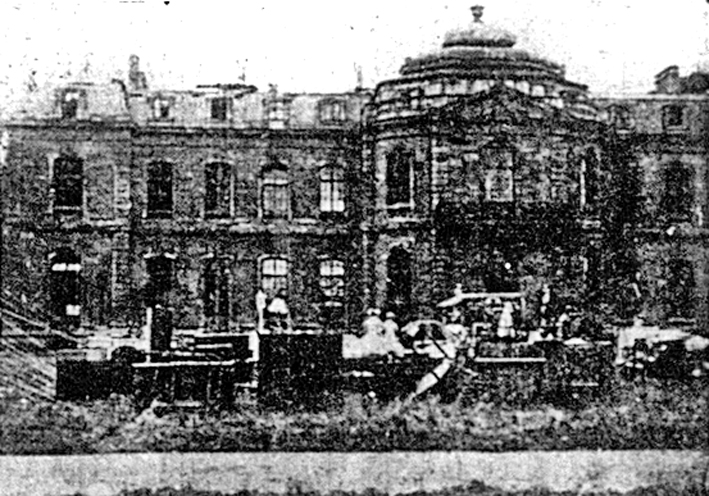Wrest Park fire and evacuation
Event date
Classifications
Source
Source Date

Up to 200 wounded soldiers were safely evacuated by V.A.D. nurses from Wrest Park mansion when a devastating fire broke out on Thursday, September 14th, 1916, at the stately home that had been in use as a military hospital since November 1914.
Damage initially estimated at around £10,000 was caused at the country home of Lord Lucas, which was extensively damaged. Any furniture, paintings, books and other valuable items that could be rescued were placed in specially erected marquees.
The Wrest Park estate fire brigade had attempted to bring the blaze under control, only to find the task too big. Eventually ten fire brigades from as far away as London were called upon to help.
First on the scene were the Luton Fire Brigade. Second Officer Andrew gave an account to the Beds & Herts Saturday Telegraph of September 16th of the brigade's involvement.
"We received the call asking for our assistance at the Wrest Park Military Hospital from the chief officer of the Wrest Park Estate Fire Brigade at 20 minutes to seven o'clock. While the men were preparing for the journey, the [telephone] exchange put me through to the Chairman of the Brigade Committee (Alderman H. O. Williams). Having received his permission, we were off like a shot and no time lost.
"The journey, nearly 11 miles to the scene of fire, occupied 22 minutes, and we touched 40 miles an hour more than once en route. We were the first arrival after, of course, the local estate brigade, and quickly got to business getting a supply of water from underground tanks with three deliveries. We worked until about half-past two o'clock in the morning."
Second Officer Andrew said one of his men, Fireman Giddings, had a narrow escape from suffocation. "While we were at work on the roof we were at first unaware that smoke and fire were driving towards us, but we managed to get him clear in time. You see, the fire was running under the roof where there was a lot of thick lead sheeting, and it could not be seen untiol the smoke had enveloped us. No, we were not wearing smoke masks."
The fire broke out in the east wing, one of the farthest points from the Bedford road. "I reckon the length of roof at about 200 ft, and two-thirds of it was destroyed. There were a lot of ambulances on the spot, and the nurses and others worked very hard to save the inmates."
Second Officer Andrew said the Luton brigade had sent one motor engine, which arrived an hour after the blaze broke out. "That was all that was necessary. It is a complete unit, you see, with pump, ladders, hose and all that is requisite, and its pumping powers seemed to surprise some of them over there."
Asked how the fire broke out, Second Officer Andrew said: "It's the old, old story where these old-fashioned buildings are concerned - a beam running into the chimney. It must have been smouldering some time, and then combustion had taken place. There should be a careful overhauling of all these old chimneys.
"When they first discovered the fire I expect they tried to tackle it with the hospital fire appliance previous to the Estate Brigade getting to work. They were, of course, prepared with extinguishers, and the hospital was fitted with hydrants.
"It was a fair-sized fire, but we managed to save the magnificent staircase which King Edward used so much to admire, and we succeeded in stopping the blaze from seriously damaging the two central domes. It is a grand mansion, and it is fortunate the damage done was no worse."
The Second Officer is particularly averse to anything like self-glorification where the Luton Brigade is concerned, said the Telegraph, but the interviewer came to the conclusion that the Luton men had rendered very valuable assistance indeed, and certainly deserve high commendation for their smart turn-out and zealous work in mastering a very serious outbreak, which might otherwise have completely demolished the stately buildings.
Before the war Wrest Park had been tenanted by the Hon Whitelaw Reid, the United States Ambassador. He had attended the opening of the Carnegie Library in Luton on October 1st, 1910, with benefactor Andrew Carnegie. In 1909, King Edward V11 had stayed at Wrest Park.
Event Place
Author: Deejaya



Add comment